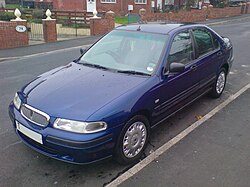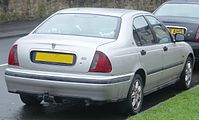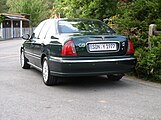Rover 400 series
| Rover 400/45 | |
|---|---|
| Production period: | 1990-2005 |
| Class : | Compact class |
| Body versions : | Sedan , hatchback , station wagon |
| Previous model: | Rover 200 (type XH) |
Rover 400 , later referred to as Rover 45 , is a lower middle class passenger car model series by the British vehicle manufacturer Rover , which was produced from spring 1990 to mid-2005. The vehicles were developed together with Honda and are technically based on the Honda Concerto (1st generation Rover 400) and the Honda Civic or Honda Domani (2nd generation Rover 400 / Rover 45).
Rover 400 (R8, 1990-1995)
| Rover 400 (R8) | |
|---|---|
|
Rover 416 GSi (1990–1995) |
|
| Production period: | 1990-1995 |
| Body versions : | Limousine , station wagon |
| Engines: |
Otto engines : 1.4–2.0 liters (66–147 kW) Diesel engines : 1.8–1.9 liters (49–65 kW) |
| Length: | 4365 mm |
| Width: | 1940 mm |
| Height: | 1400 mm |
| Wheelbase : | 2550 mm |
| Empty weight : | 1020-1160 kg |
The Rover 400 was presented in April 1990 as a four-door notchback sedan based on the Rover 200 of the 2nd generation, which has been available with a hatchback since 1989 .
Like the Rover 200, the Rover 400 emerged from a cooperation with Honda. It was based on the Honda Concerto , which was also available in Europe and was produced together with the Rover 400 at the Rover plant in Longbridge. The Rover took over the body and various mechanical components of the Honda model, but the interior came from the Rover 200. In the summer of 1993, the station wagon called the Tourer was added. It was produced until 1998 because no station wagon was developed for the 2nd generation of models. The diesel engines (1.8-liter turbocharged, 1.9-liter naturally aspirated) came from PSA Peugeot Citroën .
With a wheelbase of 2550 mm, the vehicles were 4365 mm long, 1940 wide and 1400 mm high. The curb weight was given as 1020 to 1160 kg.
Rover 400 (HH-R, 1995-1999)
| Rover 400 (HH-R) | |
|---|---|
|
Rover 400 hatchback |
|
| Production period: | 1995-1999 |
| Body versions : | Sedan , notchback |
| Engines: |
Otto engines : 1.4–2.0 liters (55–100 kW) Diesel engines : 2.0 liters (63–77 kW) |
| Length: | 4315-4490 mm |
| Width: | 1680-1695 mm |
| Height: | 1395-1400 mm |
| Wheelbase : | 2620 mm |
| Empty weight : | 1120-1210 kg |
The second generation of the Rover 400 was launched in May 1995 as a hatchback sedan and shortly afterwards as a notchback sedan. The model was technically based on the five-door Honda Civic , which also appeared in the spring of 1995. Rover had reworked the 3rd generation Rover 200, also presented in 1995, on its own, and from then on this model series was further developed independently.
1.4-liter and 1.6-liter engines of the Rover K-series, a 1.6-liter SOHC engine of the Honda D-series (only with automatic transmission) and the 2.0-liter were used as drive -Gasoline engine of the Rover T-series as well as the 2.0-liter turbodiesel of the larger Rover 600 series . The Rover 400 series corresponded in size to the Ford Escort , but Rover provided the dashboard with wood applications (the strip in the dashboard was made of real veneer, the strips in the doors and center console were imitation) and placed the model on the price Ford Mondeo level. As a result, despite initial success, the cars could no longer reach the sales figures of the first 200/400 generation.
This Rover series was already well equipped in the basic version and could be further upgraded with extras such as an alarm system with ultrasonic interior monitoring, leather upholstery, air conditioning, electric sliding glass roof and four-fold electric window regulators, etc., whereby the 400 series satisfied high demands. The supply of spare parts is ensured to this day (as of 2016) due to the cooperation with Honda at the time. As a used car, the version with the 1.6l Honda SOHC engine is particularly preferred, since the Rover K-series engines suffered from problems with weak cylinder head gaskets, which often burned out and resulted in expensive repairs.
With a wheelbase of 2620 mm, the sedans were 4315 mm long, 1695 mm wide and 1395 mm high. The dimensions of the station wagon were 4370 mm long, 1680 mm wide and 1400 mm high. The curb weight was given as 1120 to 1210 kg.
Rover 45 (1999-2005)
| Rover 45 | |
|---|---|
|
Rover 45 hatchback (1999-2004) |
|
| Production period: | 1999-2005 |
| Body versions : | Limousine , station wagon |
| Engines: |
Otto engines : 1.4–2.0 liters (76–110 kW) Diesel engine : 2.0 liters (74 kW) |
| Length: | 4362 mm |
| Width: | 1696 mm |
| Height: | 1394 mm |
| Wheelbase : | 2620 mm |
| Empty weight : | 1180-1340 kg |
In autumn 1999, the Rover 400 was for a group-wide restructuring under the leadership of BMW in Rover 45 renamed and undergone an extensive facelift. The external appearance was mainly based on the new Rover 75 .
The petrol engines with 1.4, 1.6 and 1.8 l displacement and the 2.0 l diesel were taken over from the 400 series, the 2.0 l four-cylinder petrol engine was replaced by the 2.0 l I-V6 of the larger Rover 75 replaced, the latter was only available as a notchback version.
The 45 got the better seats from the larger 75 and improved wheel suspensions to achieve a balanced driving behavior and better cornering ability. As a result, the Rover 45 (especially from 2003, when it shared the chassis components with the MG models) achieved and outperformed most of its competitors in driving characteristics.
The Rover 45 was also available with a CVT transmission that came from the German supplier ZF Friedrichshafen and was already used in the MG F / TF. The special design of the CVT transmission had an oil-cooled laminated steel belt (with an external oil cooler) that ran on sliding cones. This led to many complaints, which the MG Rover Group referred to the German supplier. Since BMW operated the MG Rover manufacturing facility for manual transmissions, Rover had to buy the transmissions from BMW. When BMW raised prices, later Rover 25/45 models with a displacement of up to 1.6 liters were equipped with Ford transmissions.
Initially, the Rover 45 sold well thanks to its good equipment, comfortable interior and reduced prices. Sales fell as better-equipped and more modern competitors such as the Peugeot 307 and Renault Mégane appeared. Compared to its competitors, the styling of the 45, which was still based on the Honda Domani from 1992, looked outdated, although the driving dynamics were on a par with or better than those of the competition.
With an unchanged wheelbase of 2620 mm, the vehicles were 4362 mm long, 1696 mm wide and 1394 mm high. The curb weight was given as 1180 to 1340 kg.
Facelift
From summer 2001 the MG ZS was offered as a sporty and more elegant variant. A facelift in the spring of 2004 was the last attempt by the MG Rover Group to improve sales of the Rover 45. It received a new front and a new rear, a revised dashboard, a newly tuned chassis, improved equipment and was also sold at a discount, which was necessary due to the end of production of the Honda Domani in Japan . Production ended when the MG Rover Group went bankrupt.
successor
Starting in 2001, the MG Rover Group tried to replace the 45 with a new model based on a shortened Rover 75 platform. This vehicle was code-named "RDX60" and was first presented as the "Rover TCV". It would have been larger than its competitors and would have had similarly luxurious driving characteristics as the Rover 75.
Even during the construction phase, however, MG Rover's design partner, Tom Walkinshaw Racing (TWR), had to register a settlement as it had to stand up for its Formula 1 team Arrows . MG Rover thus lost most of the CAD drawings for the new car, causing a loss of £ 100 million. Finally, MG Rover had to pay another million to TWR's sequester to get the CAD drawings back. As a result of this setback, the MG Rover Group lost many designers, model designs and sources and was no longer able to start over.
A rescue initially seemed possible after a joint venture between MG Rover and the Chinese SAIC was considered. It took the SAIC more than a year to approve the proposal; After this crucial period, however, MG Rover had no more financial means, as the revised models 25, 45 and 75 no longer sold well and the 75 V8 was finally released.
Individual evidence
- ↑ Cars without a successor (Fig. 41) on Autobild.de (accessed on August 4, 2010)











